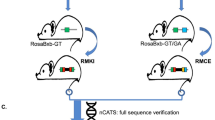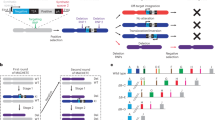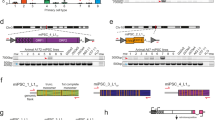Abstract
Insertional mutagens such as viruses and transposons are a useful tool for performing forward genetic screens in mice to discover cancer genes. These screens are most effective when performed using hundreds of mice; however, until recently, the cost-effective isolation and sequencing of insertion sites has been a major limitation to performing screens on this scale. Here we present a method for the high-throughput isolation of insertion sites using a highly efficient splinkerette-PCR method coupled with capillary or 454 sequencing. This protocol includes a description of the procedure for DNA isolation, DNA digestion, linker or splinkerette ligation, primary and secondary PCR amplification, and sequencing. This method, which takes about 1 week to perform, has allowed us to isolate hundreds of thousands of insertion sites from mouse tumors and, unlike other methods, has been specifically optimized for the murine leukemia virus (MuLV), and can easily be performed in a 96-well plate format for the efficient multiplex isolation of insertion sites.
This is a preview of subscription content, access via your institution
Access options
Subscribe to this journal
Receive 12 print issues and online access
$259.00 per year
only $21.58 per issue
Buy this article
- Purchase on Springer Link
- Instant access to full article PDF
Prices may be subject to local taxes which are calculated during checkout


Similar content being viewed by others
References
Greenman, C. et al. Patterns of somatic mutation in human cancer genomes. Nature 446, 153 (2007).
Mikkers, H. & Berns, A. Retroviral insertional mutagenesis: tagging cancer pathways. Adv. Cancer Res. 88, 53 (2003).
Dupuy, A.J. et al. Mammalian mutagenesis using a highly mobile somatic Sleeping Beauty transposon system. Nature 436, 221 (2005).
Keng, V.W. et al. Forward genetic screen for hepatocellular carcinoma associated genes. Proceedings of the 99th Annual Meeting of the American Association for Cancer Research (San Diego, 2008).
Wu, X. et al. Murine metastatic medulloblastoma driven by Sleeping Beauty transposition identifies genes and pathways important for medulloblastoma initiation and progression. Proceedings of the 99th Annual Meeting of the American Association for Cancer Research (San Diego, 2008).
Bender, A.M. et al. Sleeping Beauty mediated gliomagenesis. Proceedings of the 99th Annual Meeting of the American Association for Cancer Research (San Diego, 2008).
Collier, L.S. et al. Cancer gene discovery in solid tumours using transposon-based somatic mutagenesis in the mouse. Nature 436, 272 (2005).
Cuypers, H.T. et al. Murine leukemia virus-induced T-cell lymphomagenesis: integration of proviruses in a distinct chromosomal region. Cell 37, 141 (1984).
Ochman, H., Gerber, A.S. & Hartl, D.L. Genetic applications of an inverse polymerase chain reaction. Genetics 120, 621 (1988).
McAleer, M.A., Coffey, A.J. & Dunham, I. DNA rescue by the vectorette method. Methods Mol. Biol. 226, 393 (2003).
Devon, R.S., Porteous, D.J. & Brookes, A.J. Splinkerettes-improved vectorettes for greater efficiency in PCR walking. Nucleic Acids Res. 23, 1644 (1995).
Hui, E.K., Wang, P.C. & Lo, S.J. Strategies for cloning unknown cellular flanking DNA sequences from foreign integrants. Cell Mol. Life Sci. 54, 1403 (1998).
Hengen, P.N. Vectorette, splinkerette and boomerang DNA amplification. Trends Biochem. Sci. 20, 372 (1995).
Uren, A.G. et al. Large-scale mutagenesis in p19(ARF)- and p53-deficient mice identifies cancer genes and their collaborative networks. Cell 133, 727 (2008).
Margulies, M. et al. Genome sequencing in microfabricated high-density picolitre reactors. Nature 437, 376 (2005).
Wang, G.P. et al. HIV integration site selection: analysis by massively parallel pyrosequencing reveals association with epigenetic modifications. Genome Res. 17, 1186 (2007).
Mikkers, H. et al. High-throughput retroviral tagging to identify components of specific signaling pathways in cancer. Nat. Genet. 32, 153 (2002).
Marra, M.A., Kucaba, T.A., Hillier, L.W. & Waterston, R.H. High-throughput plasmid DNA purification for 3 cents per sample. Nucleic Acids Res. 27, e37 (1999).
Mullikin, J.C. & McMurragy, A.A. Techview: DNA sequencing. Sequencing the genome, fast. Science 283, 1867 (1999).
Parameswaran, P. et al. A pyrosequencing-tailored nucleotide barcode design unveils opportunities for large-scale sample multiplexing. Nucleic Acids Res. 35, e130 (2007).
Giordano, F.A. et al. New bioinformatic strategies to rapidly characterize retroviral integration sites of gene therapy vectors. Methods Inf. Med. 46, 542 (2007).
Kong, J., Zhu, F., Stalker, J. & Adams, D.J. iMapper: a web application for the automated analysis and mapping of insertional mutagenesis sequence data against Ensembl genomes. Bioinformatics 24, 2923 (2008).
Kustikova, O.S., Modlich, U. & Fehse, B. Retroviral insertion site analysis in dominant haematopoietic clones. Methods Mol. Biol. 506, 373 (2009).
Ambrosi, A., Cattoglio, C. & Di Serio, C. Retroviral integration process in the human genome: is it really non-random? A new statistical approach. PLoS Comput. Biol. 4, e1000144 (2008).
Acknowledgements
A.G.U., J.K., M.v.L. and A.B. are funded by the NWO Genomics program and the Netherlands Genomics Initiative/Netherlands Organization for Scientific Research (NWO). D.J.A. and his laboratory are funded by Cancer Research-UK and the Wellcome Trust. L.v.d.W. is funded by the Kay Kendall Leukemia Fund. We thank L. Collier for critically reading this manuscript.
Author information
Authors and Affiliations
Corresponding authors
Ethics declarations
Competing interests
The authors declare no competing financial interests.
Supplementary information
Supplementary Table 1
10 bp sequences suitable for 'barcoding' splinkerette products for 454 sequencing. These sequences facilitate the computational 'demultiplexing' of pooled splinkerette-PCR products following 454 sequencing. (PDF 18 kb)
Rights and permissions
About this article
Cite this article
Uren, A., Mikkers, H., Kool, J. et al. A high-throughput splinkerette-PCR method for the isolation and sequencing of retroviral insertion sites. Nat Protoc 4, 789–798 (2009). https://doi.org/10.1038/nprot.2009.64
Published:
Issue Date:
DOI: https://doi.org/10.1038/nprot.2009.64
This article is cited by
-
High-throughput functional screen identifies YWHAZ as a key regulator of pancreatic cancer metastasis
Cell Death & Disease (2023)
-
Nonlinear control of transcription through enhancer–promoter interactions
Nature (2022)
-
Genome-wide screening in the haploid system reveals Slc25a43 as a target gene of oxidative toxicity
Cell Death & Disease (2022)
-
Self-limiting fall armyworm: a new approach in development for sustainable crop protection and resistance management
BMC Biotechnology (2022)
-
LUMI-PCR: an Illumina platform ligation-mediated PCR protocol for integration site cloning, provides molecular quantitation of integration sites
Mobile DNA (2020)
Comments
By submitting a comment you agree to abide by our Terms and Community Guidelines. If you find something abusive or that does not comply with our terms or guidelines please flag it as inappropriate.



